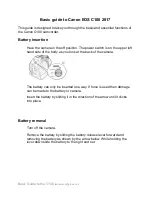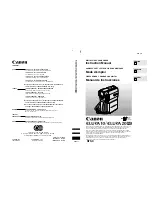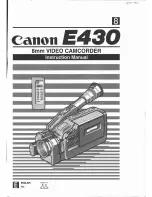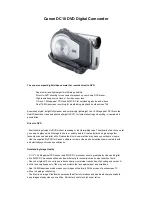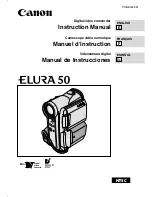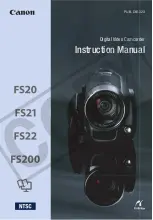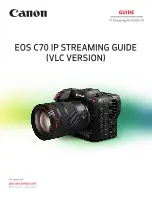
Get
ting St
ar
te
d
Precautions / Phenomena Specific to CMOS Image Sensors
5
Getting Started
Precautions
Operating or storage location
• Operating or storing the camera in the following
locations may cause damage to the camera:
– Extremely hot or cold places (Operating
temperature: 0
°
C to 40
°
C [32
°
F to 104
°
F])
– Exposed in direct sunlight for a long time, or close
to heating equipment (e.g., near heaters)
– Close to sources of strong magnetism
– Close to sources of powerful electromagnetic
radiation, such as radios or TV transmitters
– Locations subject to strong vibration or shock
• Use of a mobile phone close to this camera may cause
a malfunction of the camera or affect the quality of
images. You are cautioned to turn off any mobile
phone near the camera.
Ventilation
To prevent heat buildup, do not block air circulation
around the camera.
Transportation
When transporting the camera, repack it as originally
packed at the factory or in materials equal in quality.
Cleaning
• Use a blower to remove dust from the lens or optical
filter.
• Use a soft, dry cloth to clean the external surfaces of
the camera. Stubborn stains can be removed using a
soft cloth dampened with a small quantity of detergent
solution, then wipe dry.
• Do not use volatile solvents such as alcohol, benzene
or thinners as they may damage the surface finishes.
Maintenance
The camera mechanism may cause abnormal noise due
to wear and lubrication loss after a long period of use. To
maintain optimum performance, we recommend
periodical maintenance. If abnormal noise occurs,
consult with your Sony dealer.
Phenomena Specific to
CMOS Image Sensors
The following phenomena that may appear in images are
specific to CMOS (Complementary Metal Oxide
Semiconductor) image sensors. They do not indicate
malfunctions.
White flecks
Although the CMOS image sensors are produced with
high-precision technologies, fine white flecks may be
generated on the screen in rare cases, caused by cosmic
rays, etc. This is related to the principle of CMOS image
sensors and is not a malfunction.
The white flecks especially tend to be seen in the
following cases:
• when operating at a high environmental temperature
• when you have raised the gain (sensitivity)
This symptom may be improved by turning the camera
off and then on again.
Aliasing
When fine patterns, stripes, or lines are shot, they may
appear jagged or flicker.
Focal plane
Owing to the characteristics of the pickup elements
(CMOS image sensors) for reading video signals,
subjects that quickly move across the screen may appear
slightly skewed.
Flicker
If recording is made under lighting produced by
discharge tubes, such as fluorescent, sodium, or
mercury-vapor lamps, the screen may flicker, colors
may vary, or horizontal stripes may appear distorted. In
such cases, turn the FLICKER CANCEL function on
(see page 34).
In some cases, such phenomena may not be improved
with the FLICKER CANCEL function.
It is recommend to set the shutter speed to 1/100 sec. in
the areas of 50 Hz power supply frequency and to 1/60
in the areas of 60 Hz.
Note on laser beams
Laser beams may damage a CMOS image sensor. You are
cautioned that the surface of a CMOS image sensor should
not be exposed to laser beam radiation in an environment
where a laser beam device is used.
Содержание BRC-Z700 - CCTV Camera
Страница 91: ......





















